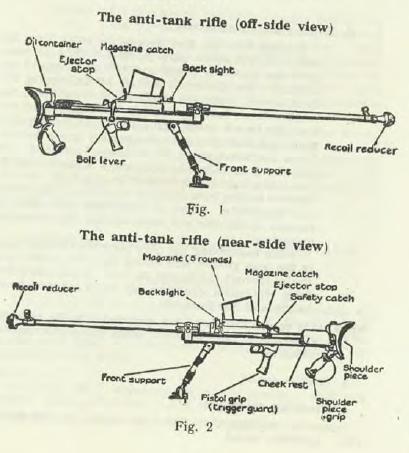As light tank development progressed through the interwar years, most nations worked on producing antitank weapons for the infantry. Early on, this was done by solid projectile, as early tanks were relatively lightly armored. Armor was quickly increased during WWII, and solid bullets had to replaced by explosives for effective infantry antitank weapons. However, at the outset of the war many countries had large caliber antitank rifles, such as the PTRS/PTRD, Mauser 1918, Lahti, Solothurn, PzB38, and Boys.
The Boys AT Rifle was put into production in England in 1937, and was effective against light tanks at that time. It was a fairly orthodox bolt action design, using a 5-round magazine and a .55 caliber (14mm) projectile at 2640fps. Initial doctrine had the Boys considered effective to 500 yard, but this dropped as the war progressed, and even with improves projectiles (tungsten core) effective range dropped to 300 yards, with 100 being recommended. While tanks because too heavily armored to be much threatened by the Boys, it continued to be useful against gun emplacements and light armored vehicles such as halftracks and scout cars.
By far the biggest complaint against the Boys is its heavy recoil. Despite a muzzle brake, recoil-absorbing stock slide mechanism and heavy recoil pad, it had a reputation for punishing recoil. As a result, it was often fired from fixed mounts, such as off a Bren or Universal carrier.
It the US, the Boys is considered a Destructive Device because its barrel exceeds .50 caliber. Between this and the scarcity of .55 ammunition, many guns have been converted to .50 Browning. This allows much more available ammunition to be used, and removes the requirement to register the gun.
We have only one piece of Boys documentation at the moment, a South African Small Arms Training manual from 1942. We are working on getting more, but in the meantime you can find a lot of good info on the Boys at rifleman.org.uk.



These AT guns are like grandfathers of modern anti materiel sniper rifles … except today they fight something “less armoured” than tanks 🙂
The .22LR Enfield rifle attached from side looks funny … I thing better solution for practicing is the device where .22lr gun is built in cartridge dimensions!
They necked down the .55’s case to .303 caliber … that looks impressing ! I thought 7.92x107mm Maroszek is the strongest .30cal, but this must be more powerful and faster.
My late uncle Ken Wallace served overseas with the R.C.O.C. and decades later he spoke of the Boyes recoil with a shudder! Some things one does not forget.
Have you seen this you-tube training video for the Boys Anti Tank rifle. It’s supposed to be Disney created. http://www.youtube.com/watch?v=rODm7HF5lFU It’s in three parts. My bet would be that you’d be interested in the second part – http://www.youtube.com/watch?v=z9lIO8AL3ds&feature=related It explains how to load, fire and what to target with the gun.
James Pilant
Hi there
I have just purchased a latter model boys ATR and I am having 50 rounds made for firing! Any precautions I should take ? Ear plugs and muffs are certain !
And I think a target bout 500 meters away!
It’s an awesome rifle ! Has it’s own presence along side my other rifles !
Cheers
Ted
You seem to have gotten the name right in the text but the title name is spelled wrong. I’m sure the good Major is rolling over in his grave from all those who put an “e” in his name. You guys normally do a really good job with these odd and obscure weapons. Any chance of fixing the Major Boys name?
biff
Whoops…it’s been fixed now.
I’m always tempted by the Boys because my range prohibits the 50 BMG – and nothing else. Or maybe convert it into a smoothbore and fire a saboted round out of it.
Pictures of the .55-303 Boys, as well as an arsenal mockup/test round for the proposed tungsten cored Boys load:
http://i120.photobucket.com/albums/o191/aoe276/Docu0001.jpg
http://i120.photobucket.com/albums/o191/aoe276/Boys3.jpg
That .55-.303 is NUTS!!! I can’t even begin to imagine the muzzle velocity they got out of it.
My grandfather carried a Boys when he was captured in WW2, North Africa. His account:
“in action I was officially a stretcher-bearer but I used to carry an anti-tank rifle. It was a ‘Boys’ but I wasn’t really allowed to. We came up against Rommels tanks… I was firing this anti-tank rifle but I could see them bouncing off it.”
A shell landed near my grandfather and the advancing Germans took their position.
Wondered about the misspelling Boyes and where it got started. Found out the German army official nomenclature for captured weapons included it as Panzerbuchse Boyes. Then I found a 1939 reprint of the Small Arms Training Manual volume 1 no. 5 published by a commercial printer that is labelled “Boyes’ Anti-Tank Rifle”. The original 1937 manual doesn’t use the Boys name in the title at all, referring to it as “Anti-tank Rifle”.